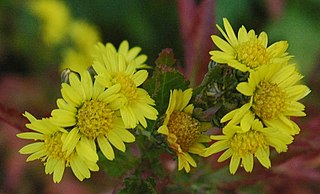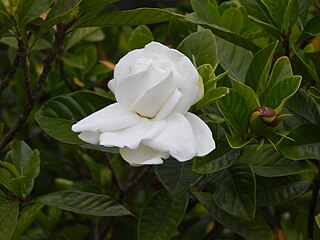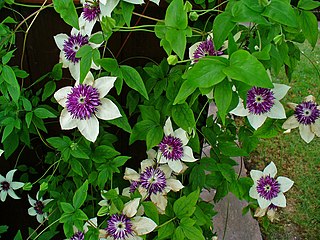
Tropaeolum, commonly known as nasturtium, is a genus of roughly 80 species of annual and perennial herbaceous flowering plants. It was named by Carl Linnaeus in his book Species Plantarum, and is the only genus in the family Tropaeolaceae. The nasturtiums received their common name because they produce an oil similar to that of watercress.

Clematis is a genus of about 380 species within the buttercup family, Ranunculaceae. Their garden hybrids and cultivars have been popular among gardeners, beginning with Clematis 'Jackmanii', a garden staple since 1862; more cultivars are being produced constantly. They are mainly of Chinese and Japanese origin.

A daylily or day lily is a flowering plant in the genus Hemerocallis, a member of the family Asphodelaceae, subfamily Hemerocallidoideae, native to Asia. Despite the common name, it is not in fact a lily. Gardening enthusiasts and horticulturists have long bred daylily species for their attractive flowers. Thousands of cultivars have been registered by local and international Hemerocallis societies. Daylilies are perennial plants, whose name alludes to its flowers, which typically last about a day.

Fuchsia is a genus of flowering plants that consists mostly of shrubs or small trees.

Chrysanthemums, sometimes called mums or chrysanths, are flowering plants of the genus Chrysanthemum in the family Asteraceae. They are native to East Asia and northeastern Europe. Most species originate from East Asia and the center of diversity is in China. Countless horticultural varieties and cultivars exist.

The cardoon, Cynara cardunculus, also called the artichoke thistle, is a thistle in the family Asteraceae. It is a naturally occurring species that also has many cultivated forms, including the globe artichoke. It is native to the western and central Mediterranean region, where it was domesticated in ancient times and still occurs as a wild plant.

Lunaria annua, commonly called honesty or annual honesty, is a species of flowering plant in the cabbage and mustard family Brassicaceae. It is native to southern Europe, and cultivated throughout the temperate world.

The cottage garden is a distinct style that uses informal design, traditional materials, dense plantings, and a mixture of ornamental and edible plants. English in origin, it depends on grace and charm rather than grandeur and formal structure. Homely and functional gardens connected to cottages go back centuries, but their stylized reinvention occurred in 1870s England, as a reaction to the more structured, rigorously maintained estate gardens with their formal designs and mass plantings of greenhouse annuals.

Grevillea robusta, commonly known as the southern silky oak, silk oak or silky oak, silver oak or Australian silver oak, is a flowering plant in the family Proteaceae. It is a tree, the largest species in its genus but is not closely related to the true oaks, Quercus. It is a native of eastern coastal Australia, growing in riverine, subtropical and dry rainforest environments.

Agastache is a genus of aromatic flowering herbaceous perennial plants in the family Lamiaceae. It contains 22 species, mainly native to North America, one species native to eastern Asia. The common names of the species are a variety of fairly ambiguous and confusing "hyssops" and "mints"; as a whole the genus is known as giant hyssops or hummingbird mints.

Gardenia jasminoides, commonly known as gardenia and cape jasmine, is an evergreen flowering plant in the coffee family Rubiaceae. It is native to parts of South-East Asia. Wild plants range from 30 centimetres to 3 metres in height. They have a rounded habit with very dense branches with opposite leaves that are lanceolate-oblong, leathery or gathered in groups on the same node and by a dark green, shiny and slightly waxy surface and prominent veins.

Clematis montana, the mountain clematis, also Himalayan clematis or anemone clematis, is a flowering plant in the buttercup family Ranunculaceae. A vigorous deciduous climber, in late spring it is covered with a mass of small blooms for a period of about four weeks. The odorous flowers are white or pink, four-petalled, with prominent yellow anthers. It is native to mountain areas of Asia from Afghanistan to Taiwan.
Raymond John Evison OBE, VMH, FLS, FCI Hort. is a nurseryman, clematis breeder, lecturer, author and photographer. Born in 1944 he started his horticultural career at the age of 15 in Shropshire and moved to the island of Guernsey to set up The Guernsey Clematis Nursery in 1984.

Clematis armandii is a flowering climbing plant of the genus Clematis. Like many members of that genus, it is prized by gardeners for its showy flowers. It is native to much of China and northern Burma. The plant is a woody perennial. It attracts bees, butterflies, and hummingbirds.

Clematis alpina, the Alpine clematis, is a flowering deciduous vine of the genus Clematis. Like many members of that genus, it is prized by gardeners for its showy flowers. It bears 1 to 3-inch spring flowers on long stalks in a wide variety of colors. C. alpina is native to Europe; in the United States it grows best in American Horticultural Society zones 9 to 6, which are generally found in the southern USA.

Clematis integrifolia is a flowering vine of the genus Clematis. Like many members of that genus, it is prized by gardeners for its showy flowers. C. integrifolia bears nodding, urn-shaped blue flowers in summer that are 1.5 inches wide. It is a fairly short variety, growing only to 3 feet high. It is native to Europe and Asia. In the USA it grows best in American Horticultural Society zones 8 to 1.

Clematis lanuginosa is a flowering vine of the genus Clematis. Like many members of that genus, its hybrids are prized by gardeners for their showy flowers. It is endemic to Zhejiang province in eastern China and was first discovered near Ningbo by the plant hunter Robert Fortune in 1850 who sent plants back to England. It was lost to cultivation at about the time of the first world war and thought to be extinct but was rediscovered growing in the same area in 2008.

Clematis heracleifolia, the tube clematis, is a species of flowering plant in the buttercup family Ranunculaceae, native to central and northern China. Unlike most other members of the genus Clematis, it has a scrambling rather than a climbing habit.

Clematis florida, the Asian virginsbower, or passion flower clematis, is a species of flowering plant in the family Ranunculaceae. It is native to southern China, and has been introduced to Korea and Japan. A perennial vine, in the wild it is typically found in shrublands and thickets, and alongside streams, at elevations around 1,700 m (5,600 ft). There are a number of cultivars commercially available, including 'Sieboldiana', Pistachio 'Evirida'PBR, and 'Plena'.

















